
Across the Philippines, Local Civil Registry Offices work closely with the Philippine Statistics Authority (PSA) to ensure the accurate documentation of vital events such as deaths. These records serve as the foundation for both personal legal documents and national demographic analysis. Their collaboration plays a crucial role in maintaining reliable data, which is essential for policymaking, governance, and sustainable development. Proper registration of these vital events enables the government to plan public services effectively, allocate resources efficiently, and monitor population trends, contributing to the overall progress of the nation. Registered Deaths by Year.
In the year 2023, the total number of registered deaths in the Philippines reached 694,821. This figure represents a 2.2 percent increase compared to the total number of registered deaths in 2022, which was recorded at 679,766. The increase in the number of deaths from 2022 to 2023 indicates a difference of 15,055 additional registered deaths within a one-year period. Furthermore, when compared to the total number of registered deaths in 2021, which was 879,429, the 2023 figure reflects a 21.0 percent decrease. This means that there were 184,608 fewer deaths recorded in 2023 compared to 2021. The data highlights the variations in the annual number of registered deaths over a three-year period, showing how the figures have changed from 2021 to 2023 based on official records.
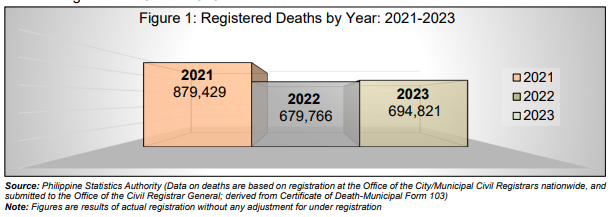
Registered Deaths by Site and Region of Occurence
Among all regions, National Capital Region recorded the highest number of deaths, totaling 96,411, which represents 13.9 percent of the nationwide count. In contrast, the Bangsamoro Autonomous Region in Muslim Mindanao (BARMM) registered the lowest number of deaths, with 6,560 or 0.9 percent of the total.
Based on the total number of registered deaths in the Philippines, the MIMAROPA Region ranked 14th among the 17 regions with the highest recorded deaths. A total of 18,726 deaths were registered in the region, accounting for 2.7 percent of the national total, as shown in Figure 2. Although MIMAROPA was among the regions with relatively lower death counts, it still contributed a notable share to the overall figure.
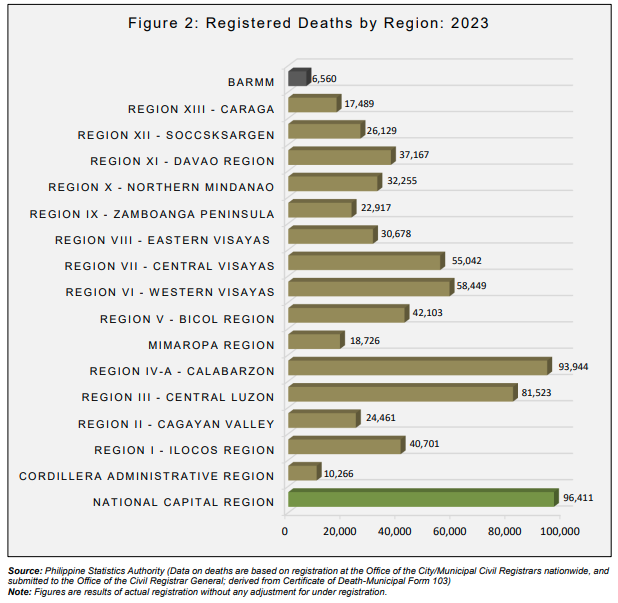
Registered Deaths by Sex
In the recorded data for the specified year, a higher number of male deaths were registered compared to female deaths. A total of 393,319 male deaths were recorded, representing a 56.6 percent of all registered deaths nationwide. In contrast, the number of female deaths was recorded at 301,502, accounting for 43.4 percent of the total, as illustrated in Figure 3.
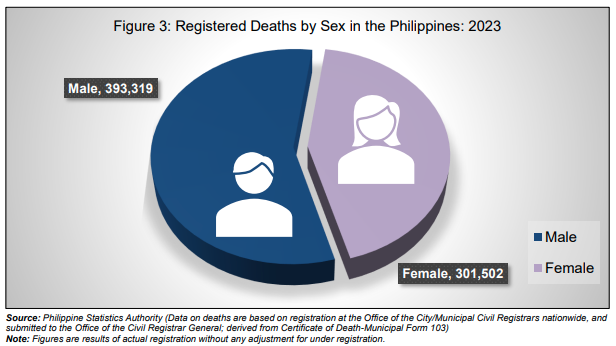
Similarly, in the MIMAROPA region, the number of male deaths was higher than that of females. The region recorded 11,909 male deaths, while female deaths totaled 8,124. Male deaths in MIMAROPA constituted 1.6 percent of the total national deaths, whereas female deaths accounted for 1.2 percent, as shown in Figure 4. The data indicates a consistent trend across both the regional and national levels, where the mortality rate among males remains higher.
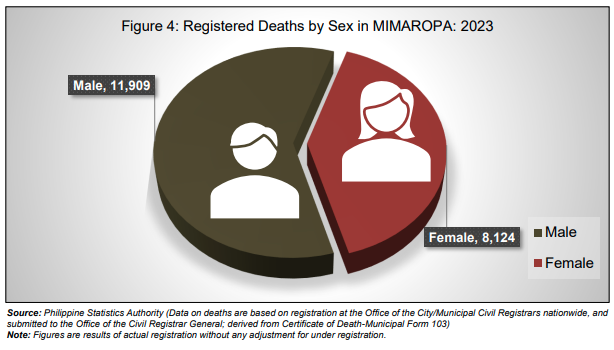
Registered Deaths by Month
The monthly records for the specified year show that January had the highest number of registered deaths across the Philippines, with a total of 60,891, accounting for 8.8 percent of the overall national figure. In contrast, February recorded the lowest number of registered deaths, with 52,536 cases, making up 7.6 percent of the total at the national level (Figure 5).

Registered Deaths by Age Group
The recorded data on deaths by age group indicates that individuals aged 70-74 years had the highest number of registered deaths nationwide, accounting for 11.2 percent of the total. In contrast, the lowest number of deaths was observed among individuals aged 5-9 years, comprising only 0.6 percent of the overall count (Figure 6). The distribution of deaths across various age groups reflects variations in mortality rates among different segments of the population.
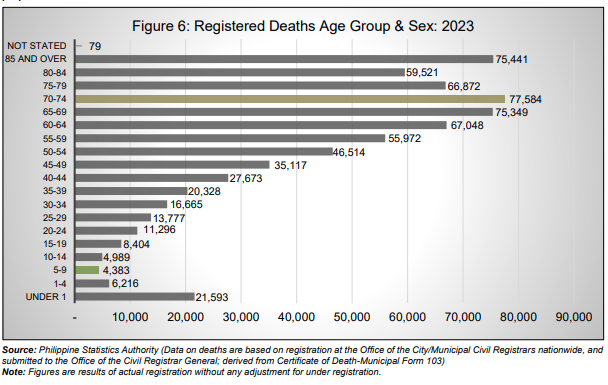
Registered Deaths by Age Group and Sex
The recorded data on male deaths indicates that the highest number of deaths occurred in the 65-69 age group, with a total of 46,270 cases, representing 11.8 percent of the total male deaths. Conversely, the lowest number of male deaths was observed in the 5-9 age group, accounting for only 0.6 percent. On the other hand, for female deaths, the highest number was recorded among individuals aged 85 and above, comprising 17.3 percent of the total female deaths. Meanwhile, the lowest number of female deaths was recorded in the 5-9 age group, with a total of 1,887 cases, also representing 0.6 percent (Figure 7). The distribution of deaths across different age groups for both males and females highlights variations in mortality rates within specific age ranges. The recorded figures provide a detailed breakdown of deaths categorized by sex and age, reflecting the numerical differences observed across different demographic groups.
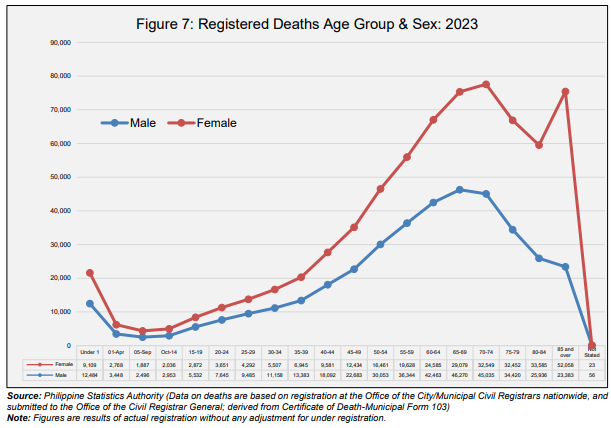
Registered Deaths by Attendant
The recorded data indicates that out of the total registered deaths, 355,176 cases, representing 51.1 percent, were attended, while 336,922 cases, or 48.5 percent, were unattended. Further, 2,723 deaths, accounting for 0.4 percent, had no information regarding an attendant (Figure 8).
Among the attended deaths, the majority were handled by hospital authorities, with a total of 303,569 cases, representing 43.7 percent of the total deaths. In contrast, the lowest number of attended deaths was recorded under the care of private physicians, totaling 17,239 cases or 2.5 percent. Furthermore, a total of 3,093 deaths, equivalent to 0.4 percent, were attended by other designated personnel (Figure 8). The data provides a comprehensive numerical breakdown of the distribution of attended and unattended deaths. It also highlights the varying roles of different medical professionals and institutions in handling end-of-life care.

Registered Deaths by Site of Occurrence
The recorded data on the site of death occurrences shows that the majority of deaths took place at home, with a total of 367,687 cases, accounting for 52.9 percent of the overall registered deaths. In comparison, 322,714 deaths, or 46.4 percent, occurred in health facilities. Additionally, there were 58 cases where the place of death was not specified.
This distribution highlights the varying settings in which deaths occurred, reflecting the accessibility and utilization of healthcare facilities across the country. The data also underscores the significant number of deaths that occurred outside of healthcare institutions, pointing to the need for further understanding of factors influencing this trend.
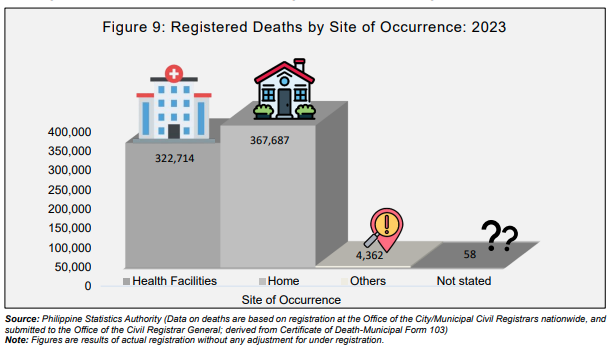
Registered Deaths by Registration Status
Regarding the registration status of the recorded deaths, a total of 683,874 deaths, representing 98.4 percent, were registered within the prescribed period. In contrast, 10,947 deaths, representing 1.6 percent, were registered beyond the official deadline (Figure 10). This data reflects a high level of compliance with the regulatory requirements for timely death registration.
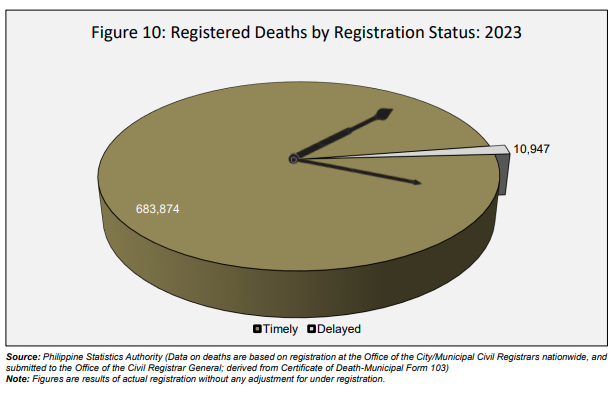

(SGD)GEMMA N. OPIS
Chief Statistical Specialist
PSA PSO Marinduque
GNO/ASL

